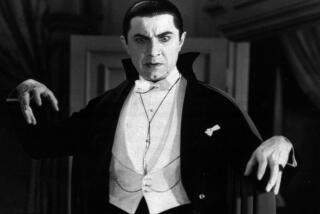Drawn and quartered
- Share via
BILL GAINES was supposed to be a chemistry teacher, but blood, ink and Dexedrine sweat carried him down a different path. He had a passion for science and a quirky mania for measurements; to organize his desk, he used a ruler and T square, arranging his blotter, stapler and letter opener in a precise pattern. None of that mattered, though, after his father, comics publisher M.C. Gaines, died in a boating accident on Lake Placid in August 1947. Gaines’ mother implored her son, who had been finishing his studies at New York University, to take over the family business, Educational Comics, a torpid little enterprise based in a low-rent office on Lafayette Street in New York’s Little Italy.
Gaines moaned that he was running the “smallest, crummiest outfit in the field,” but within a few years he had made a name for himself and EC Comics, as it came to be known. This was due to a startlingly deep reserve of creative talent -- including Harvey Kurtzman, Wally Wood, Frank Frazetta, Johnny Craig and John Severin -- and a flair for gore, mayhem and gruesome twist endings. Working with Al Feldstein, one of his partners in comics crime, Gaines would stay up until dawn on diet medication, tearing through magazines and short stories looking for ideas he could pinch for EC’s “Crime SuspenStories” or “Tales From the Crypt.”
Somehow, the teacher-in-training had become a merchant of lurid pulp and, in the eyes of some culture crusaders, a predator. In April 1954, Gaines, like one of the Mafia dons who also operated out of his neighborhood, found himself testifying before a Senate subcommittee.
Gaines’ congressional appearance is one of the climactic moments in “The Ten-Cent Plague: The Great Comic-Book Scare and How It Changed America,” David Hajdu’s history of the very serious attack on funny books. Here, Hajdu doggedly documents a long national saga of comic creators testing the limits of content while facing down an ever-changing bonfire brigade. That brigade was made up, at varying times, of politicians, lawmen, preachers, medical minds and academics. Sometimes, their regulatory bids recalled the Hays Code; at others, it was a bottled-up version of McCarthyism. Most of all, the hysteria over comics foreshadowed the looming rock ‘n’ roll era; like Elvis and his pelvis, the funny books encoded adult titillations in packages sold to a young audience.
“The Ten-Cent Plague” traces the shrill sound of alarm all the way back to 1906, when Ralph Bergengren harrumphed in the Atlantic Monthly that the comic strip “Katzenjammer Kids” and its four-color ilk were committing multiple crimes against society. “Respect for property,” he wrote, “respect for parents, for law, for decency, for truth, for beauty, for kindliness, for dignity, or for honor are killed, without mercy.” That was almost half a century before Gaines and his gleeful crew sharpened up their axes.
The most memorable crusades against comics, though, took place in the 1940s and 1950s as part of a response to surging “juvenile delinquency,” a term Hajdu smartly deconstructs. In his view, it’s an umbrella label, “a way to define a range of phenomena involving young people that, to the prevailing adult authorities, seemed to represent a falling short, a delinquency, in youthful behavior. It defined by negation: Like most criticism of the comics, the words ‘juvenile delinquency’ characterized their subject by its failure to meet expectations -- not by what it was, but by what a disappointment it was.”
The establishment response to delinquency was perhaps most vividly expressed in the pages of this very newspaper, which in June 1943 published a breathless opinion piece by none other than FBI chief J. Edgar Hoover, who warned that the war raging overseas wasn’t the only threat to America’s future.
“This country is in deadly peril,” the iconic G-man (or his ghostwriter) declared. “For a creeping rot of disintegration is eating into our nation. I am not easily shocked nor easily alarmed. But today, like thousands of others, I am both shocked and alarmed. The arrests of ‘teen-age’ boys and girls, all over the country are staggering.” The piece went on to tell of boys shoplifting, stealing cars and robbing filling stations, as well as girls who drank in taverns, got “coarse and vulgar” and ended up in “houses of ill fame.”
It’s hard now not to chuckle at that language, at both the message and the messenger. “We are fighting a war to establish the Four Freedoms for the generation now coming to maturity,” Hoover concluded. “We had better make sure that they have the self-discipline to live in a free world.”
Hoover’s column is just one of the aromatic artifacts that Hajdu digs up for the book, and he does a good job cherry-picking the details. By 1949, for instance, the police department in Cleveland (where Superman’s creators lived) had two full-time police officers on the “comic-book beat.” In April of that year, a poor fellow by the name of William Dickey was arrested at his Florence Avenue drugstore in Walnut Park for selling a comic book to a teenager. The title of the comic, fittingly, was “Crime Does Not Pay.”
If anything, though, Hajdu goes too wide with his viewfinder, adding example after example of municipal maneuvers and genre trends. He might have found a more human aspect to the story had he lingered longer on individuals such as Gaines, who went on to great success with Mad magazine after EC Comics imploded in the wake of his grilling on Capitol Hill.
Of course, comic book creators are less scintillating than the musicians Hajdu has written about in the past. (He is author of the dazzling 1960s folk-scene portrait “Positively 4th Street: The Lives and Times of Joan Baez, Bob Dylan, Mimi Baez Farina, and Richard Farina” and the equally compelling “Lush Life: A Biography of Billy Strayhorn.”) When he focuses on them, however, he frames the loopy players in this tale with flair. Take this fantastic description of the Munich-born psychiatrist Frederic Wertham, author of the screed “Seduction of the Innocent,” and the zealous Anita Bryant of the anti-comics movement: “A compact middle-aged man with brushed-back gray hair and a high forehead hatched with scowl lines, he peered slightly to one side through opaque horn-rimmed glasses. He was wearing a plain, dark tie and a white lab coat, and his expression suggested puzzlement and displeasure. . . . With this image, the emerging crusade against comic books had a face.”
Wertham was as much a cartoon as the characters in the comics he railed against. Were he still around, he would be positively stricken by, say, Grand Theft Auto, the modern equivalent of EC’s blood lust.
Yet despite the bonfires and the shuttered publishers, the comic books in “The Ten-Cent Plague” have fared far better than the good doctor and his sour peerage. Gaines is now part of a garish gallery of pop culture agitators that includes Sam Fuller and R. Crumb, Eminem and Quentin Tarantino, N.W.A and Howard Stern. More than that, it would take tens of thousands of dollars to put together a library of those vintage EC Comics -- if only because, like defiant martyrs, so many of them went up in smoke.
--
--
On the Web
To read J. Edgar Hoover’s 1943 Los Angeles Times opinion piece, go to latimes.com/hoover.
For a gallery of images from “The Ten-Cent Plague,” go to latimes.com/comicbooks.
More to Read
The biggest entertainment stories
Get our big stories about Hollywood, film, television, music, arts, culture and more right in your inbox as soon as they publish.
You may occasionally receive promotional content from the Los Angeles Times.










